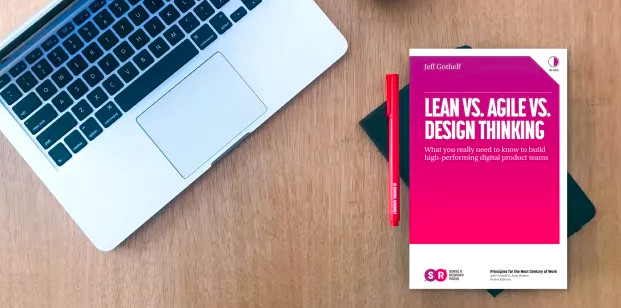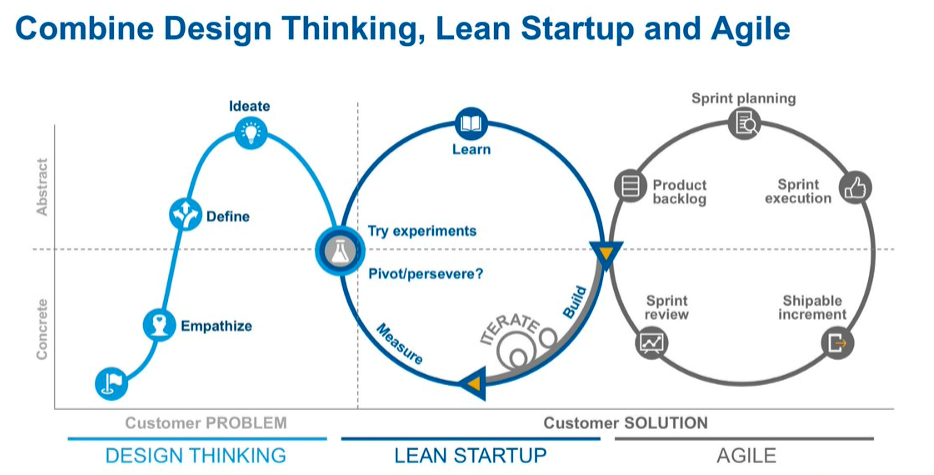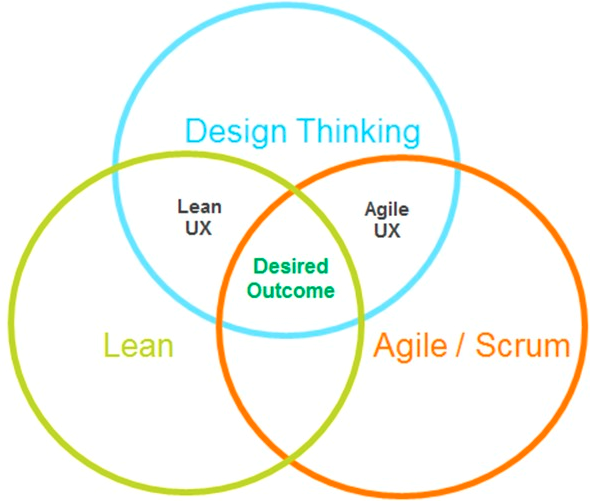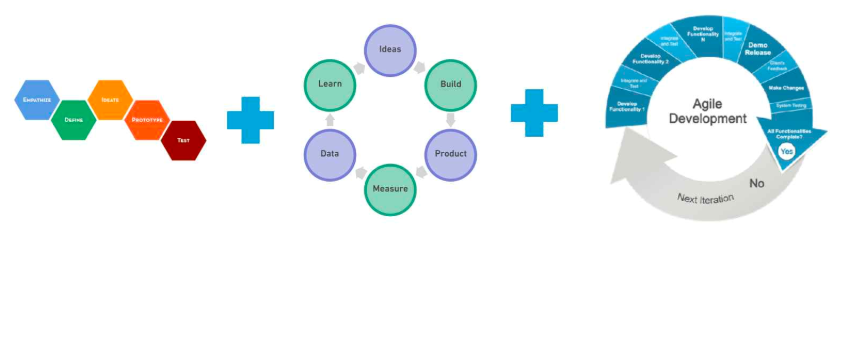Erasing and drawing lines: Agile, Lean and Design thinking

Introduction
Agile and Lean are some of the most commonly used terms in SDLC lifecycle. Often these terms are used interchangeably or as complimentary to each other. There are similarities as well as points of divergence between these approaches, and it takes years of practical hands on work to sort out the nuances.
Agile software development framework refers to 12 principles and 4 values that were put forth in Agile Manifesto which became the basis for an alternate method of software development to replace the waterfall methodology. Agile was primarily a reaction by the software community of engineers and sponsors who wanted to see faster progress and cut any bureaucracy, red tapism or flab in the system. The existing heavy-lifting style of waterfall development caused as many troubles as it resolved through delivery of the software systems. Disconnected teams, uninterested project sponsors, disappointed customers, cost and time overrun, and a software system in disarray and out of sync with customers’ needs were quite often the remnants of a waterfall implementation.
Agile gained traction as a better answer for delivering software while Lean was adapted and refined on product success in conventional manufacturing. Design thinking is a relatively abstract approach for exploring problems and solutions with customer in mind.
In any business or services enterprise, blindly committing any model, framework, or methodology seldom delivers a positive result, let alone the desired result. Different LOBs or departments may have their own unique problems which go against the grain of ‘one solution fit all approach’. The need is to marry available choices with the needs of an organization in a way that each option selected returns the best possible ROI with acceptable levels of risk.
The intersection of Agile way, Lean manufacturing and Design thinking presents an interesting combination of techniques to progressively achieve improvements in software delivery. An unbiased examination of all three techniques in detail, potential and scalability reveals interesting areas of coupling, while there also exist enough reasons to adapt adequate cautions.
“Be stubborn on the vision, but flexible on the details.”
—Jeff Bezos
Agile, Lean and Design Thinking examined
Agile is our ticket to scalable, collaborative and customer-centric software development; Lean is the framework for achieving efficiencies and applying learning to achieve process improvements, and Design Thinking is an innovative approach to attacking problems through iterative exploration and application of learnings.
Design thinking is a way of getting to the solution of a problem through continuously questioning the previous outcomes. Design thinking often advocates going where the rules don’t exist and where precedents are unknown. Design thinking is more to do with learning ability than following a set path. A cook conjures up new dishes and a designer comes up with a new dress line in much the similar fashion. It’s through thinking about the user of the product and coming up with attributes that would deliver the most value that designers come up with the most effective design elements.
Design Thinking often focuses on the subtleties of how deep look in to problems can lead to ingenious solutions. Abstract attributes like experimentation, dealing with ambiguities, empathetic learning and above all, a designer’s ability to make meaning out of otherwise ignorable facts, hold special place in Design Thinking. Simply put, Design Thinking is a study in to how problems are framed and analyzed and how an empathetic approach of looking at problems from customers’ or users’ point of view can often bring out subtle hints towards solutions. Design Thinking challenges assumptions, encourages innovative ideas, prototyping and experimentation, and defining users’ needs and pain points. Much of the Design Thinking process is similar to Agile, insofar as iterations, late changes, customer centricity and flexibility are concerned.
The heart of Agile way, irrespective of the chosen Agile method is to react to change. Agile is a dynamic approach to delivering software of value to the customer where the customers and engineers became collaborators to produce the software. Agile is highly effective in uncertainty and is the perfect answer to many professionals and designers’ worst nightmare of not being able to change the product design during later stages of development. Scaling Agile is a critical part of Agile implementation helping organizations address changing requirements without raising everything to ground.
Lean approach developed in the manufacturing world primarily as a cost saving tool. Based on cold, hardcore scientific methods of reducing waste through processes, rules, procedures and value addition, Lean was primarily control oriented. While Agile and Design Thinking advocate flexibility, less reliance on processes and empathetic learning, Lean often runs in opposite direction. One of the major drawbacks of Lean is that conventionally it often ends at process optimization, waste, and quality, and misses so much of what the Lean mindset offers potentially. However, Lean deals with uncertainty and advocates an adaptive approach, changing according to results of experimentation and learning. Lean framework also advocates empowering those closest to the work to decide the best approach of doing work under strict supervision and control. Hence, there are ample synergies between the Agile and Lean approaches.
The lean startup methodology was invented in Silicon Valley in the 90s, powered by the dot com boom but the conventional Lean has its roots in Toyota’s production system. Toyota’s lean manufacturing system was used to build things efficiently, yet it doesn’t tell what should be built.

Using Hybrid mix of Agile, Lean and Design Thinking
Many projects can and do fail despite best intentions. According to various studies, anywhere between 30-50% of IT projects fail to achieve their objectives. A study by IDC points out that 30-35 percent of IT projects still fail. Other research puts the figure upwards of 50 percent. Regardless of the study, the main reason consistently cited for the failure of software development projects to deliver their intended outcomes is misalignment with user and business needs.
Agile, Lean and Design Thinking place high focus on close collaboration with users and people closest to the work being done. While Design Thinking focuses on finding the right problem through empathetic approach and listening to the users, Agile places emphasis on collaboration and feedback loop, while Lean advocates placing power in the hands of those doing the work. Just like design thinking, a key tenet of effective agile application, irrespective of the Agile framework chosen, is to seek frequent inputs from end users and incorporate the feedback in iterations to achieve the right outcomes. Doing this during early stages of projects includes establishing project goals, defining business increments, writing user stories and / or features, establishing success criteria through definition of done and creating product backlogs from which iteration backlogs follow. Throughout the development process, the inputs through feedback process manifests form a crucial part of delivering the ‘right’ product .

While design thinking and agile can be applied separately, benefits’ realization can be higher if the two approaches are applied together, creating an environment where both approaches benefit off each other. This environment fosters a ‘customer/user first’ attitude and equips employees with means and methods to focus on user-centricity and rapid iteration as a means of reaching optimal outcomes. Design thinking brings a strong user focus while agile is an excellent way to deliver product incrementally, ensuring customer / user needs are kept at top and center throughout entire design and development phases.
For teams looking to leverage agile and design thinking for the first time, here are few recommendations to keep in mind:
- Fail early, fail often – No idea is a bad idea. During the brainstorming sessions or ideation phases, any criticism of any idea is simply not permissible. Each team member is free to put up their idea on the board so long as it’s a fair representation of users / customers’ needs. A critical part of Design Thinking is to come up with prototypes and working models, which are often very poor adaptation of users / customers’ needs however serve as a vital link. The prototypes are shown to users / customers to get feedback and incorporate learnings. Poor prototypes have perhaps taught design teams more than any other source. The goal is to understand the needs of the users / customers empathetically.
- Low hanging fruits – By starting small and focusing on high-value, yet low-risk opportunities, confidence and experience both grow in applying principals of using design thinking and agile together. Then, as the capability matures, teams can take on more challenging initiatives.
- Create cross-functional teams – This is perhaps one of the easiest yet so-often-delivered-wrong concepts. By allowing team to leverage cross-functional viewpoints, for example, a developer may have critical feedback on UI, team leaders can tap in to experience from various domains. This not only fosters required creativity, but also creates a healthy understanding of each other’s challenges within the team. As far as possible, the team must be physically collocated with end users / customers to promote frequent collaboration.
- Balance design and development – Agile teams are often groomed to go in to an iteration mode, basically an all-guns-blazing mindset. And that’s not wrong. Typically, Agile teams learn and implement on the fly. Agile teams are often instructed to “just start coding”, fixing problems as they come along and gathering user / customer feedback along the way. Care needs to be taken while mixing Agile and Design Thinking as this may create tensions about how much time to spend on resolving problems before starting development. The team must understand that this isn’t a pure-play Agile implementation, or a pure-play Design phase which can take ages. The team must understand the value of the empathy, definition, and ideation phases, and that Design Thinking is not leveraged only at the front, rather it can crop up during any phase. In fact, the team must be prepared and encouraged to get back to the beginning at any point during project to uncover new user insights and / or reframe the problem, and then continue development with a renewed sense of “why”.

Conclusion
At a simplistic level, Design Thinking can essentially be described as a process that leverages divergent thinking (to generate ideas and get out of the box solutions), followed by convergent, team thinking to select solutions to pursue, all the while getting user / customer feedback. Design thinking is a mindset towards solving problems from human needs perspective rather than from a business perspective.